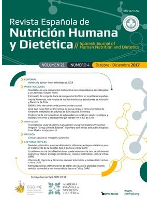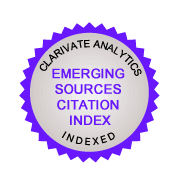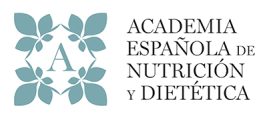The use of herbs in patients with inflammatory bowel disease in Türkiye: A cross-sectional study
DOI:
https://doi.org/10.14306/renhyd.28.2.2364%20Keywords:
Inflammatory Bowel Diseases, Ulcerative Colitis, Crohn Disease, Medicinal PlantsAbstract
Introduction: Ulcerative colitis (UC) and Crohn's disease (CD), known as inflammatory bowel disease (IBD), which are becoming increasingly common around the world, are chronic conditions that affect people's quality of life. This study aims to evaluate the use of herbal products by adults diagnosed with IBD in remission and to investigate the factors associated with the use of herbal products.
Methodology: This study was conducted on 425 adult participants aged 18-65 years (Males = 154, Females = 271) diagnosed with IBD (UC = 295, CD = 130) who were referred to the gastroenterology outpatient clinics of two university hospitals. Data were collected using a questionnaire with three parts: socio-demographic, disease-related, and use of herbal products.
Results: The most commonly used medicinal plants were Zingiber officinale Roscoe (40.5%), Curcuma longa L. (38.1%) and Momordica charantia L. (24.2%). There was a significant difference in the use of herbal products according to the presence of chronic diseases in addition to IBD (p<0.001). 44.4% of participants did not report their use of these herbal products to health professionals. The use of herbal products decreased with increasing age (95% CI:0.946-0.999) and educational level (for bachelor 95% CI: 0.141-0.857, for postgraduate 95% CI: 0.178-0.711) and increased with increasing duration of diagnosis (95% CI:1.049-1.134). In addition, the use of herbal products was higher in people who had not had surgery related to IBD (95% CI:1.658-11.628) and who did not have comorbidities (95% CI:1.836-11.607).
Conclusions: Age, educational level, duration of disease, undergoing surgery related to IBD and having comorbidities are factors affecting the use of herbal products in patients with IBD. However, studies with larger sample sizes are needed to fully elucidate these relationships.
References
(1) Guzzo GL, Andrews JM, Weyrich LS. The neglected gut microbiome: Fungi, protozoa, and bacteriophages in inflammatory bowel disease. Inflamm Bowel Dis. 2022; 28(7): 1112-1122. https://doi.org/10.1093/ibd/izab343.
(2) Rogler G, Singh A, Kavanaugh A, Rubin DT. Extraintestinal manifestations of inflammatory bowel disease: Current concepts, treatment, and implications for disease management. Gastroenterology. 2021; 161(4): 118-1132. https://doi.org/10.1053/j.gastro.2021.07.042.
(3) Sara JC, Zielińska M, Sokal A, Filip R. Genetic and epigenetic etiology of inflammatory bowel disease: An update. Genes. 2022; 13(12): 2388. https://doi.org/10.3390/genes13122388.
(4) Szymczak-Tomczak A, Ratajczak AE, Kaczmarek-Ryś M, Hryhorowicz S, Rychter AM, Zawada A et al. Pleiotropic effects of vitamin D in patients with inflammatory bowel diseases. J Clin Med. 2022; 11(19): 5715. https://doi.org/10.3390/jcm11195715.
(5) Zhou Y, Wang D, Yan W. Treatment effects of natural products on inflammatory bowel disease in vivo and their mechanisms: based on animal experiments. Nutrients. 2023; 15(4): 1031. https://doi.org/10.3390/nu15041031.
(6) Adam H, Alqassas M, Saadah OI, Mosli M. Extraintestinal manifestations of inflammatory bowel disease in middle Eastern patients. J Epidemiol Glob Health. 2020; 10(4): 298-303. https://doi.org/10.2991/jegh.k.200330.001
(7) Agrawal M, Allin KH, Petralia F, Colombel JF, Jess T. Multiomics to elucidate inflammatory bowel disease risk factors and pathways. Nat Rev Gastroenterol Hepatol. 2022; 19: 399–409. https://doi.org/10.1038/s41575-022-00593-y.
(8) Rodrigues BL, Mazzaro MC, Nagasako CK, Ayrizono MLS, Fagundes JJ, Leal RF. Assessment of disease activity in inflammatory bowel diseases: Non-invasive biomarkers and endoscopic scores. World J Gastrointest Endosc. 2020; 12(12): 504-520. https://doi.org/10.4253/wjge.v12.i12.504.
(9) Tontini GE, Vecchi M, Pastorelli L, Neurath MF, Neumann H. Differential diagnosis in inflammatory bowel disease colitis: State of the art and future perspectives. World J Gastroenterol. 2015; 21(1): 21-46. https://doi.org/10.3748/wjg.v21.i1.21.
(10) Yeshi K, Ruscher R, Hunter L, Daly NL, Loukas A, Wangchuk P. Revisiting inflammatory bowel disease: Pathology, treatments, challenges and emerging therapeutics including drug leads from natural products. J Clin Med. 2020; 9(5): 1273. https://doi.org/10.3390/jcm9051273.
(11) Disli M, Yesilada E. Herbal medicinal products in Turkey (Standardization, production and adulteration of herbal products in Turkey). J Biotechnol and Strategic Health Res. 2019; 3(Special issue): 13-21. https://doi.org/10.34084/bshr.545498.
(12) Uzun MB, Aykac G, Ozcelikay G. Improper use and harms of herbal products. Mersin University Faculty of Medicine Lokman Hekim Journal of Medical History and Folkloric Medicine. 2014; 4(3): 1-5.
(13) Cheifetz AS, Gianotti R, Luber R et al. Complementary and alternative medicines used by patients with inflammatory bowel diseases. Gastroenterology 2017; 152: 415–429. https://doi.org/10.1053/j.gastro.2016.10.004.
(14) Hung A, Kang N, Bollom A, et al. Complementary and alternative medicine use is prevalent among patients with gastrointestinal diseases. Dig Dis Sci. 2015; 60: 1883–1888. https://doi.org/10.1007/s10620-014-3498-3.
(15) Bitbol V, Lahmek P, Buisson A, et al. Impact of complementary and alternative medicine on the quality of life in inflammatory bowel disease: Results from a French national survey. Eur J Gastroenterol Hepatol. 2014; 26: 288–294. https://doi.org/10.1097/meg.0000000000000040.
(16) Picardo S, Altuwaijri M, Devlin SM, Seow CH. Complementary and alternative medications in the management of inflammatory bowel disease. Therap Adv Gastroenterol. 2020; 13: 1756284820927550. https://doi.org/10.1177/1756284820927550.
(17) Lin SC, Cheifetz AS. The use of complementary and alternative medicine in patients with inflammatory bowel disease. Gastroenterol Hepatol (N Y). 2018;14(7): 415-425.
(18) Minhas HJ, Papamichael K, Cheifetz AS, Gianotti RJ. A primer on common supplements and dietary measures used by patients with inflammatory bowel disease. Ther Adv Chronic Dis. 2023; 14: 20406223231182367. https://doi.org/10.1177/20406223231182367.
(19) Tezcan S, Butur M. Evaluation of the attitudes and practices of patients regarding the use of herbal products. J. Fac. Pharm. Ankara. 2022; 46(3): 817-826. https://doi.org/10.33483/jfpau.1122581.
(20) Tulunay M, Aypak C, Yikilkan H, Gorpelioglu S. Herbal medicine use among patients with chronic diseases. J Intercult Ethnopharmacol. 2015; 4(3): 217–220. https://doi.org/10.5455/jice.20150623090040.
(21) Mbizo J, Okafor A, Sutton MA, Leyva B, Stone LM, Olaku O. Complementary and alternative medicine use among persons with multiple chronic conditions: Results from the 2012 National Health Interview Survey. BMC Complement Altern Med. 2018; 18(1): 281. https://doi.org/10.1186/s12906-018-2342-2.
(22) Peltzer K, Pengpid S. The use of herbal medicines among chronic disease patients in Thailand: A cross-sectional survey. J Multidiscip Healthc. 2019; 12: 573-582. https://doi.org/10.2147/JMDH.S212953.
(23) Lucenteforte E, Gallo E, Pugi A, Giommoni F, Paoletti A, Vietri M et al. Complementary and alternative drugs use among preoperative patients: a cross-sectional study in Italy. Evid Based Complement Alternat Med. 2012; 2012: 527238. https://doi.org/10.1155/2012/527238.
(24) Dursun Sİ, Vural B, Keskin B, Kaçar HK, Beyhan A, Kadıoğlu H. The relationship between traditional/complementary medical attitude and health literacy and health perception in adults. Journal of Public Health Nursing. 2019; 1(1): 1-10.
(25) Haliloglu B, Isguven P, Yıldız M, Arslanoglu İ, Erguven M. Complementary and alternative medicine in children with type 1 diabetes mellitus. J Clin Res Pediatr Endocrinol. 2011; 3(3): 139-143. https://doi.org/10.4274/jcrpe.v3i3.27.
(26) Bauer, N.; Kairey, L.; Schlee, C.; Uecker, C.; Oznur, O.; Langhorst, J. Use of complementary and alternative medicine (CAM) in patients with inflammatory bowel disease (IBD): Results from a German nationwide survey of 2019 compared to a previous survey of 2002. Scand. J. Gastroenterol. 2022; 57: 1209–1215. https://doi.org/10.1080/00365521.2022.2078667.
(27) Lakatos, PL, Czegledi Z, David G, Kispal Z, Kiss LS, Palatka K, Kristof T, Nagy F, Salamon A, Demeter P et al. Association of adherence to therapy and complementary and alternative medicine use with demographic factors and disease phenotype in patients with inflammatory bowel disease. J Crohns Colitis. 2010; 4: 283-290. https://doi.org/10.1016/j.crohns.2009.11.011.
(28) Oxelmark L, Lindberg A, Lofberg R, Sternby B, Eriksson A, Almer S, Befrits R, Fossum B, Karlén P, Brostrom O et al. Use of complementary and alternative medicine in Swedish patients with inflammatory bowel disease: A controlled study. Eur J Gastroenterol Hepatol. 2016; 28: 1320–1328. https://doi.org/10.1097/meg.0000000000000710.
(29) Opheim R, Bernklev T, Fagermoen MS, Cvancarova M, Moum B. Use of complementary and alternative medicine in patients with inflammatory bowel disease: Results of a cross-sectional study in Norway. Scand. J. Gastroenterol. 2012; 47: 1436–1447. https://doi.org/10.3109/00365521.2012.725092.
(30) Park DI, Cha JM, Kim HS, Park HJ, Shin JE, Hong SN, Hong SS, Kim WJ. Predictive factors of complementary and alternative medicine use for patients with inflammatory bowel disease in Korea. Complement Ther Med. 2014; 22: 87–93. https://doi.org/10.1016/j.ctim.2013.12.001.
(31) Tassew WC, Assefa GW, Zeleke AM, Ferede YA. Prevalence and associated factors of herbal medicine use among patients living with chronic disease in Ethiopia: A systematic review and meta-analysis. Metabololism Open. 2024; 21: 100280. https://doi.org/10.1016/j.metop.2024.100280.
(32) Barlin D, Ercan A. Conditions of use of food and vegetable products in the adults having digestive system problems. The Turkish Journal of Academic Gastroenterology. 2019; 19(1): 31-37. https://doi.org/10.17941/agd.708506.
(33) Ongan D. Habit of using herbal products of adults living in Kayseri. JHS. 2018; 27(2): 125-131.
(34) Ozcelik G, Toprak D. Why is phytotherapy preferred? Ankara Medical Journal. 2015; 15(2). https://doi.org/10.17098/amj.05190.
(35) Nur N. Knowledge and behaviours related to herbal remedies: A cross-sectional epidemiological study in adults in Middle Anatolia, Turkey. Health Soc Care Community. 2010; 18(4): 389-395. https://doi.org/10.1111/j.1365-2524.2010.00911.x.
(36) Hacıhasanoglu Asılar R, Arıkan Hacıhasanoglu S, Yıldırım A, Sahin, H. Tip 2 Determination of herbal complementary health approach uses in type 2 diabetes mellitus patients: a cross-sectional study. TJFMPC. 2023; 17(1): 10-21. https://doi.org/10.21763/tjfmpc.1169238.
(37) Solak Y, Kaya E, Yoldascan B. Knowledge and attitudes of those applying to a family health center regarding herbal products and herbal treatments. Fırat Medical Journal. 2020; 25(4): 213-218.
(38) Kav T. Use of complementary and alternative medicine: A survey in Turkish gastroenterology patients. BMC Complement Altern Med edicine. 2009; 9(41): 41-50. https://doi.org/10.1186/1472-6882-9-41.
(39) Nordeng H, Havnen GC. Use of herbal drugs in pregnancy: A survey among 400 Norwegian women. Pharmacoepidemiol Drug Saf. 2004; 13(6): 371-380. https://doi.org/10.1002/pds.945.
Downloads
Published
How to Cite
Issue
Section
License
Copyright (c) 2020 Ecenur Bayir, Cagla Ayer, Gulsah Kaner, Gozde Elgin-Cebe

This work is licensed under a Creative Commons Attribution-NonCommercial-ShareAlike 4.0 International License.











